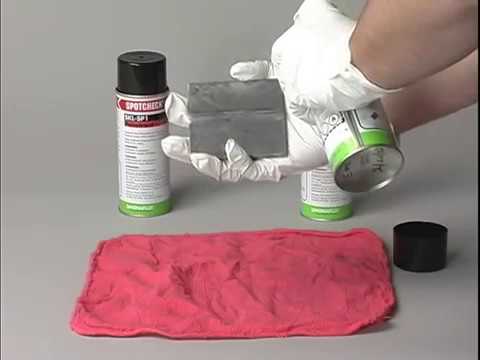INSTRUCTIONS FOR USE
1. Pre-cleaning: Spray the surfaces to be cleaned liberally with SKC-S then either wipe off or allow to air dry, or soak a clean cloth with the cleaner and wipe the part clean. Allow the part to dry thoroughly before applying the penetrant.
2. Apply Penetrant: Spray or brush the part or section to be inspected so that surface is covered with penetrant. If penetrant pulls back in droplets stop and clean part again. (Refer to Step 1). Allow penetrant to remain on the part from 10-30 minutes. Longer penetration times may be needed for locating extremely fine or tight discontinuities.
3. Remove Penetrant: Apply SKC-S to a cloth, wipe test surface and repeat as needed. Do not spray SKC-S directly on the part because penetrant indications may be removed.
4. Apply Developer: SKD-S2 Should be applied by spray only, since dipping or brushing will cause excessive solvent action on the penetrant in discontinuities. SKD-S2 may be applied by aerosol, or conventional spray gun. SKD-S2 must be agitated during use to ensure the developer particles remain suspended during processing. Solvent-based developers like SKD-S2 should be sprayed in thin even layers, which just wet the surface. A heavy spray will cause excessive bleeding and running of indications; whereas too light a spray will result in slow indication development as well as possible loss in overall sensitivity due to limited solvent action. Allow developer to dry. Watch for large cracks to show up immediately. Smaller cracks may take a few minutes to develop the best indication.
5. Inspect Part: Defects will be marked by a deep red indication. A line or dotted line marks a crack, lap, forging burst or cold shut. If wide and deep, the indication will grow and spread. Porosity, shrinkage, lack of bond, and leaks will appear as dots or local areas of color. These, too, will grow and spread if the defect is large or extensive.





